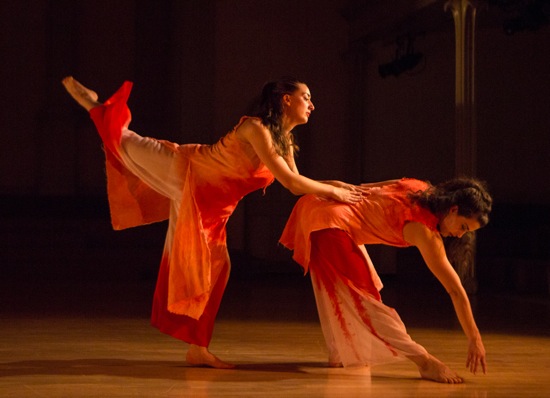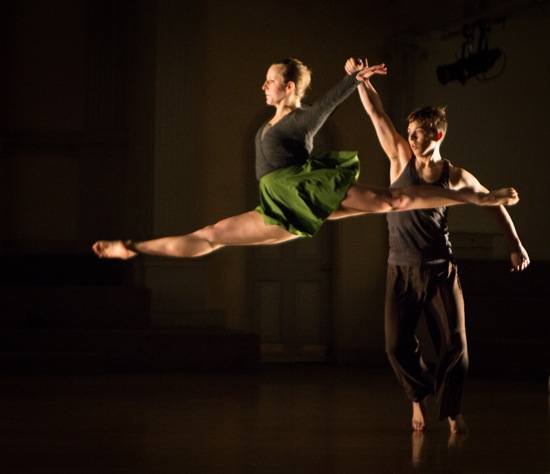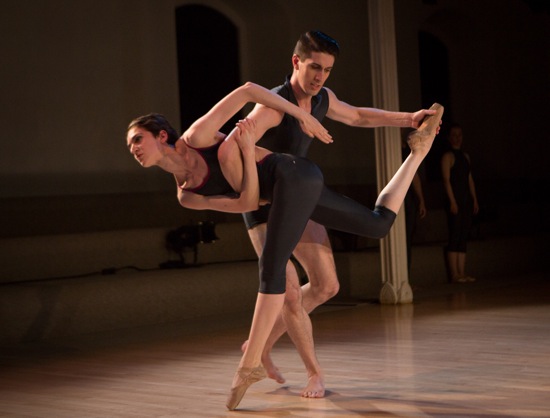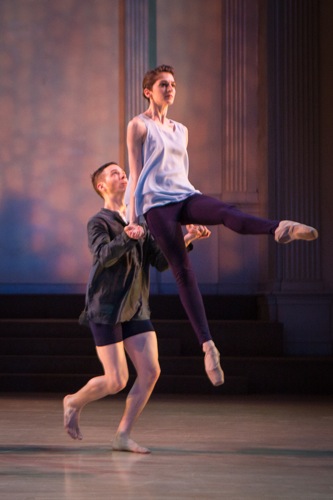For a number of years, Cherylyn Lavagnino has been working to bring together in her choreography elements that interest her deeply: the classical vocabulary that she excelled in during her days as a member of the Pennsylvania Ballet and that she teaches at NYU-Tisch School of the Arts; the modern dance that she also trained in and performed; and her feelings about society and political unrest. Although she is drawn to narratives that induce emotion, she doesn’t tell stories—preferring structures and movements that hint at them obliquely.
Cherylyn Lavagnino Dance’s performances at St. Mark’s Church (part of Danspace’s Dance:Access) reveal her company as an assembly of individuals; they have backgrounds in ballet, yet don’t look as if they fit into a ballet-company mold. For instance, you watch Claire Westby—a tall, strongly built woman—leap across the floor, devouring space, and think of her as more of a modern dancer. Selina Chau, once a member of the Hong Kong Ballet, has a slightly more contained style, while lean Giorgia Bovo from Italy creates sharper designs in space than some of the other women. Yet none of them holds anything back as they bring Lavagnino’s choreography to life in pieces that date from her 2009 Will and the 2010 Snapshots to the more recent 2014 Ru (2014) and the 2015 premiere, Naděje.
Themes of conflict, contrast, and discipline power Snapshots, set to a recorded percussion score by Kyle Olson. In its first section, Chau wears pointe shoes, while Lila Simmons does not. I don’t fully understand the reason for this distinction, but Chau dances more elegantly with her partner, Yachou Zhu (a valiant last-minute replacement for the injured Adrian Silver) than barefoot Simmons, whose contacts with Justin Faircloth are rougher and more impetuous. Yet the two pairs easily fall in and out of unison, even though, at one point, when all four are close together, Faircloth bumps against Simmons, who shoves Zhu.
Struggle crops up as a design motif, with the dancers occasionally kneeling and confronting their partners, ready to pull against each other’s one-hand grip. Four women in black (Giovanna Gamna, Christine Luciano, Eliza Sherlock-Lewis and Westby march like a well-drilled military squadron, except that their kicking legs are the guns. They cage the man who joins them (Michael D. Gonzalez), and he reaches out from their encircling arms. Faircloth and Travis Magee turn the third movement into a fight.
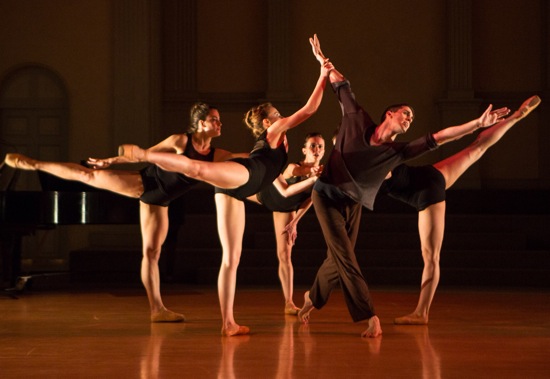
Snapshots: Michael D. Gonzalez, caught by (L to R) Claire Westby, Eliza Sherlock-Lewis, Giovanna Gamna, and (hidden) Christine Luciano. Photo: Yi-Chun Wu
I note along the way problems that face Lavagnino: how, for instance to make an arabesque not look like its iconic self—an eye-snagging beauty. Sometimes, in the interests of emotion, she (and the dancers) instead may redefine one as a plunge or stride so bold that the back leg almost has to raise; at other times you think, what’s that “step” doing here? (I felt the latter primarily in Snapshots and in Will).
The more the dancers get inside the movement and acknowledge the space and one another, the more the fragmentary dramas come to life, and these performers accomplish this most of the time. When they make a run across the stage look like a rush and a leap like an explosion, the choreography sings. Also Lavagnino has a gift for creating tangled pas deux that show the dancers making real investigations of the partners’ capabilities, instead of showing off virtuosic complexity. Watching the two duets in Will that merge their elements into a quartet (danced the night I attended by Bovo, Gonzalez, Magee, and Laura Mead), I notice the difference it makes when they investigate every movement thoroughly. Here’s one example when they miss doing this. In the skillfully designed Will, as in others of these dances, a man sometimes upends a woman (occasionally opening her crotch to the sky). Automatically, the women bend back, opening their chests to the vault overhead. I think what a difference it would make if they scanned the walls all the way up to the ceiling as they were lifted and tilted, instead of just adjusting their heads to display the finished position. I’m terrifically impressed in this and other works by Gonzalez, who combines strength and intensity with ease, so that the steps look like second nature to him. The music for Will is a spare and elegant violin solo, composed and played live by Jane Chung.
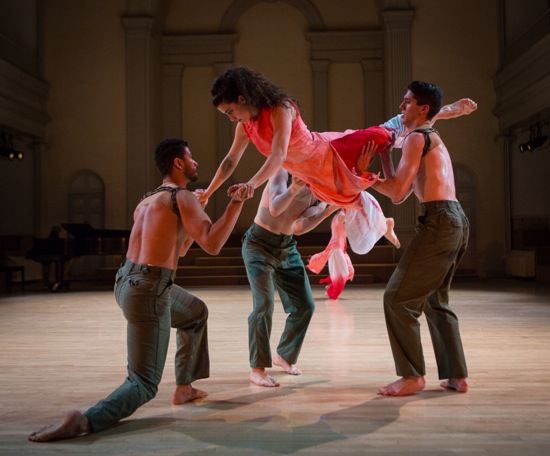
Ru: Claire Westby lifted by (L to R) Barrington Hinds, unknown, and Michael D. Gonzalez. Photo: Yi-Chun Wu
Lavgnino’s social conscience appears more prominently in the two later works. Ru, based on Kim Thuy’s novel of that name is subtitled “a refugee’s story” (Thuy, born in Saigon in 1968, emigrated to Canada by boat). Interestingly, in this work, the choreographer abandons pointe shoes altogether. The female dancers’ flame-colored tunics allude to Vietnamese culture along, as does Scott Killian’s recorded score, in which voices murmur beneath the piano and other instruments. These elements help to create a style more fluid than those in the other pieces.
Thuy wrote her story in French, and the title has different meanings depending on the language. In Vietnamese it means lullaby, but in French it signifies flow —as in a stream, but also of tears or blood. In this dance, Lavagnino’s use of the church space is inventive (the dancers have no “offstage” to disappear into, and even waiting offstage, they stay involved). The ten dancers’ focus, too, is clearer in this piece. Westby stands in for the book’s author, and—as in all the works—her focus and presence are wonderfully immediate. She is the traveler, the one who needs the four men to lift her above whatever current threatens her (Barrington Hinds joins the other three). They fall but they also rise. And for all the dancers there are images of unstable terrain, of disconsolate, stooping posture, of rituals remembered and safety hoped for.
In the evening’s premiere, Naděje, Lavagnino was inspired by another culture and its political history. The music is Leoš Janáček’s rich Violin Sonata. What a pleasure to hear its plaintive melodies and allusions to Czech folk dance played live by Chung and pianist Mohamed Shams! A program note mentions Vaclav Havel’s Letters to Olga as source material and Alphonse Mucha’s twenty gigantic paintings of scenes from Czech history and myth (maybe for its groupings?). As with Ru, the elements influenced Lavagnino’s choreographic structures are not necessarily visible to us. Her approach is poetic rather than narrative.
Costumes distinguish the women. Luciano is dressed in white, Chau and Westby wear flesh-colored dresses, and the remaining four women (Bovo, Gamna, Sherlock Williams, and Simmons) have short blue and black outifts. Their interactions with one another and with the men (Gonzalez, Magee, and Zhu) suggest alliances. At some point Kathy Kaufmann’s excellent lighting projects a greenish lattice on the arched back wall, and the relationship between Westby and Chau seems briefly tender and solicitous. The fine performers may pair up temporarily, or dance in groups, like the women in blue who hurry through, tangling as they go. At one point, Gonzalez and Luciano pass rapidly among these four, suggesting a pathway to escape, and, at the end of Naděje, these two (and one other performer, I forget who) are standing on the platform that houses the altar on Sundays, while everyone else is kneeling.
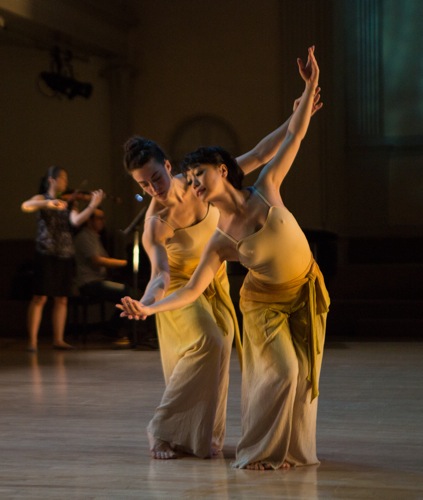
Claire Westby (L) and Selina Chau in Naděje. At back: musicians Jane Chung and Mohamed Shams. Photo: Yi-Chun Wu
As always in Lavagnino’s choreography, you get a sense of people on the go—rushing somewhere, charging ahead, finding partners or colleagues, then moving on. Designs materialize and vanish. This is a society in tumult, but full of hope—one in which structures crumble and are rebuilt in new ways.

